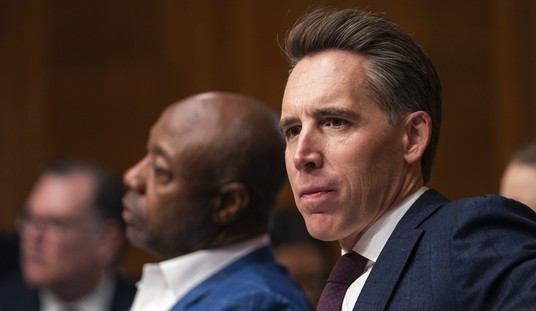
Well, Dear Readers, that went well. If you’re like me, you are probably a little sleep-deprived from a truly epic Election Night, and a detailed walk through the data will have to wait a bit (votes are still being counted, so margins of victory will be a bit of a moving target for the next week). But I have expended a lot of time and energy reading and analyzing polls for you these last six weeks, and a little bit of a victory lap is in order.
My final elections column predicted that Republicans would gain (net) 8 Senate seats and 2 Governorships, and at this writing we are at R+8 in the Senate (likely R+9 after the Louisiana runoff, with a theoretical but probably not real possibility that a recount flips Virginia to Ed Gillespie) and R+2 in the Governorships (they’re still counting votes in Alaska, but Sean Parnell seems to have joined Tom Corbett as the only GOP incumbents to lose). My guiding theory over the course of the campaign (with a hat tip to Sean Trende of RealClearPolitics for many of the key insights, which he laid out as far back as January) was that Democratic candidates – especially in the Senate – would lose badly with late-deciding voters and be drawn down towards Obama’s low approval ratings, and with the partial exception of the survival of [mc_name name=’Sen. Jeanne Shaheen (D-NH)’ chamber=’senate’ mcid=’S001181′ ] in New Hampshire, that’s mostly what happened. I thought Kansas voters stood a good chance of coming home to save [mc_name name=’Sen. Pat Roberts (R-KS)’ chamber=’senate’ mcid=’R000307′ ] and Sam Brownback despite their low poll standing, and they did. I flagged the Virginia Senate and Maryland Governor’s races as the most likely to surprise outside the usual margin of error due to late momentum, and they were the biggest shockers of the night, with [mc_name name=’Sen. Mark Warner (D-VA)’ chamber=’senate’ mcid=’W000805′ ] not pulling narrowly ahead of Gillespie until the wee hours after having a double digit lead for the whole campaign, and Larry Hogan beating Anthony Brown after also trailing by double digits since winning the GOP nomination.
So, with that bit of horn-tooting out of the way, a few first reactions to what we saw last night and what we can learn about polling, campaigns and elections going forward:
1. It Wasn’t Just The Map: A major theme of pre-election Democratic spin was that Republicans would win Senate races in deep-red territory – although Democrats might pick off a seat here or there – but that the GOP wouldn’t win beyond the lightest purple states. But not only did Republicans win Senate seats in the key Presidential battleground states of Colorado, Iowa and North Carolina and only narrowly miss seats in Virginia and New Hampshire, they also won Governors races in territory ranging from purple (Ohio, Florida, Wisconsin, Nevada) to blue (Michigan, New Mexico) to deep blue (Illinois, Massachusetts, Maryland, Maine). Even in Pennsylvania, where Corbett got blown out, the GOP added to its majorities in the state legislature; even in New York, it improved its showing in key House seats. Meanwhile, Democratic boasts that demographics would lead to gains in places like Georgia and Texas proved totally unfounded.
What does that mean going forward? At a minimum, it suggests that predictions that the GOP brand was toxic and an insuperable barrier to victory were overstated. I’ll run the numbers in more depth and detail another day, but prior to yesterday, in the seven 6th year midterms since 1950 (1950, 1958, 1966, 1974, 1986, 1998, 2006), there were 48 states in which a Senate seat changed hands (this includes one state that lost 2 Senators in one election and another that had to be re-run the following summer to resolve it). In 5 of the 48, the incumbent party gained a seat; none of those 5 states flipped in the next Presidential election. In another 5, the incumbent party lost a seat in a state the incumbent President had lost in winning re-election – 3 in 1950, plus Rick Santorum and Lincoln Chaffee in 2006. Assuming [mc_name name=’Sen. Mary Landrieu (D-LA)’ chamber=’senate’ mcid=’L000550′ ] goes down in her runoff election, Democrats will have lost seven of those races this year alone, which does support the thesis that Obama faced an unusually hostile Senate map.
But what of Colorado and Iowa? In the other 38 Senate losses in a 6th-year midterm in a state won by the incumbent in his re-election campaign, half (19) flipped in the next general election, and in 18 of the 38, the incumbent party’s share of the 2-party popular vote declined by more than it did in the nation as a whole. Recent examples of Senate losses that were followed by Presidential losses include Ohio in 2006 and 1998, Virginia in 2006 and Kentucky in 1998. So, while the variation between midterm and general electorates is noteworthy and is unusually large in the Obama era, it’s not historically the case that you can write off 6th year midterms as meaningless.
2. Momentum Mattered: If you simply blindly followed the polls at face value, you probably missed a bunch of races last night; poll averages had Republicans losing the North Carolina and Kansas Senate races, getting slaughtered in the Virginia Senate race and facing a runoff in the Georgia Senate race, and losing the Florida, Kansas, Maryland, and Illinois Governor’s races, likely facing a runoff in the Georgia Governor’s race, and losing the Vermont Governor’s race outright. Instead, Republicans won all those races outright except VA-SEN, which is still being counted, and VT-GOV, in which DGA chair Peter Shumlin failed to get a majority of the vote and will have the election decided (in his favor, obviously) by the state legislature. That’s even before we get to how badly the poll averages missed the margins of victory in a lot of races.
But if you were reading the polls with an appropriately informed and skeptical eye, you could see not only the signs that a lot of races had a stubbornly large number of undecideds who might break heavily in the GOP direction, but also that several races – most obviously the Kentucky, Georgia, Arkansas and Virginia Senate races and the Georgia, Maryland, and Wisconsin Governor’s races – had late movement in the poll averages in the GOP direction as well as the most recent polls in the averages in some cases being significantly more Republican than the earlier ones (we saw movement in the opposite direction in the Connecticut and Colorado Governor’s races, which the GOP lost, although there also appeared to be such movement in the Kansas Governor’s race).
It’s debatable how much of that movement was attributable to voters deciding late and how much was attributable to pollsters making late adjustments to their turnout models to more accurately gauge the electorate, but the point is that watching the late moves was what told me to keep an eye on VA-SEN and MD-GOV (in the latter case, you could also see the sudden rush of President and Mrs. Obama to campaign there for Brown) and what suggested that Arkansas, Kentucky and Georgia wouldn’t be close. We saw something similar in 2012 when Florida moved very late towards Obama. In the future, if you want to bank a few surprises, watch the very last few polls.
3. Unskewing Remains A Dangerous Business: So, the polls were not entirely trustworthy guides. But a lot of Democrats got burned trying to explain why polls were biased to ignore non-white and/or hard-to-find Democratic voters in Georgia and Colorado, or why early voting numbers in North Carolina and Florida or faith in get-out-the-vote magic in South Dakota and Alaska would undermine the polls. We could not have reliably predicted, beyond the factors I noted above, that the polls would be systematically skewed to underrate Republicans, as Nate Silver and others found they were – a skew that was probably caused by overcorrecting their turnout models in the direction of the 2012 trends to overcompensate for voters who are hard to locate in the initial sample. But at the same time, using our B.S. detectors on a few outlying polls was a wise move. Jeanne Shaheen did not win by 7 points, as those late polls seemed to suggest, although her win was a little better than the overall averages. [mc_name name=’Sen. Mark Begich (D-AK)’ chamber=’senate’ mcid=’B001265′ ] was not up by 9. On the other hand, the gold-standard Marquette poll in Wisconsin nailed Scott Walker’s victory better than the averages did, and the same is true for the Des Moines Register poll of Ernst in Iowa, another respected local pollster with deep roots.
Oh, and: if you were following the all-volunteer Ace of Spades HQ Decision Desk here or on Twitter last night, you were ahead of the networks in knowing when races could be called.
4. The Hidden Wages of Obamacare, Stimulus and Scandal: Brown’s shocking loss in Maryland and Shumlin’s underperformance in Vermont (he didn’t budge from his 47% in the polls, while Scott Milne fared some 11 points better than his poll average) had a common thread; both states had prominent failures of their state health care exchanges, and both governors were intimately involved (Brown, as Martin O’Malley’s Lieutenant Governor, had overseen the Maryland exchange’s failure; I wrote last year about Vermont, which continued to have troubles into this fall). Not every state with a big failure took it out on their Governor (John Kitzhaber escaped unscathed from the Cover Oregon debacle), but Brown and Shumlin had looked bulletproof. Meanwhile, late-breaking scandals assisted the loss by [mc_name name=’Sen. Kay Hagan (D-NC)’ chamber=’senate’ mcid=’H001049′ ] in North Carolina and Mark Warner’s near-defeat in Virginia, including Hagan’s family’s receipt of federal stimulus funds, her effort to promote a judge overseeing a case involving her husband, and Warner’s apparent effort to use a judgeship for a state senator’s daughter as a bribe.
5. The Strong Survive: Early in the race, you would have identified Shaheen, Warner and [mc_name name=’Sen. Al Franken (D-MN)’ chamber=’senate’ mcid=’F000457′ ] as the blue-state Senate targets with the highest approval ratings, and while Shaheen and Warner ended up in tight races due to the national and state environments, they were the only Democrats in competitive Senate races left standing, while Franken was never in jeopardy and raised insane amounts of money. (There were some early signs [mc_name name=’Sen. Jeff Merkley (D-OR)’ chamber=’senate’ mcid=’M001176′ ] in Oregon might be vulnerable, but Oregon’s electorate never budged and Monica Wehby proved a weaker candidate than she looked at first. Also Wehby was one of the few pro-choice Republicans in a target race – Scott Brown was the only one in a close race, and lost. So much for compromise on a core issue being the formula for winning the close ones.). The same was true of John Hickenlooper in the Colorado Governor’s race – he saw a strong position deteriorate badly, but had enough gas in the tank to eke out a win over Bob Beauprez. By contrast, even personally popular Senators like [mc_name name=’Sen. Mark Pryor (D-AR)’ chamber=’senate’ mcid=’P000590′ ] and [mc_name name=’Sen. Mark Begich (D-AK)’ chamber=’senate’ mcid=’B001265′ ] couldn’t overcome the deeply toxic environment in states Obama lost twice by large margins.
6. Left-Wing Social Extremism Finds Its Limits: Democrats, having played culture-war wedge issues to the hilt in 2012, talked themselves (with the media’s help) into thinking there was no such thing as too far or too loudly to the left on social issues, only too far or too loudly to the right. This led them to fail completely to appreciate the danger they faced from obsessing about taxpayer funding for sex and backing late-term abortion to the hilt. [mc_name name=’Sen. Mark Udall (D-CO)’ chamber=’senate’ mcid=’U000038′ ], dubbed “Mark Uterus” by the local media, alienated even newspapers that had previously endorsed him by running a campaign so obsessed with contraception that it drowned out every other issue, to say nothing of insulting the voters’ intelligence by pretending to believe that [mc_name name=’Rep. Cory Gardner (R-CO)’ chamber=’house’ mcid=’G000562′ ] would ban birth control. Late-term abortion filibusterer Wendy Davis set back the cause of “Battleground Texas” and its “turn Texas blue” goal by years, shriveling the Democrats’ coaliton to the point where she lost white women 67-32 and Hispanic men 50-49, on the way to losing women overall by 9 points. Even contraceptive-mandate media star Sandra Fluke lost a State Senate race against another Democrat.
Then there’s the dog that didn’t bark: guns. I often compared the Democrats’ post-Newtown push for new federal gun laws in the spring of 2013, when Obama was still riding high from re-election and gains in the Senate, to Republicans’ focus on the Terri Schiavo case in the spring of 2005 when Bush was freshly re-elected and had 55 Republican Senators. Like the conservatives of 2005, liberals/progressives were unshakeable in their certitude of the moral rightness of immediate action on the issue, and as a result underestimated the political opportunity cost of wasting the moment when they could have accomplished something more lasting or at least something of value to campaign on the following fall. But outside the Connecticut Governor’s race, it’s hard to find a race where Republicans paid any price at all for the party’s stance on guns, and no GOP Senate candidate anywhere seems ever to have even been put meaningfully on the defensive on the issue (an unsurprising fact if you looked, as I did during the Manchin-Toomey debates, at the 2014 Senate map).
7. Tomorrow’s Another Day: The first day of the Battle of Shiloh in 1862 involved a series of disasters and blunders for the Union, which nearly cost it the battle and Grant’s army before he could unify his forces and bring them to bear on the enemy. Grant’s brief conversation with Sherman – who would become his right-hand man for the rest of the war after that battle – at the end of a long, bloody day is the stuff of legend:
Late that night tough Sherman came to see him. Sherman had found himself, in the heat of the enemy’s fire that day, but now he was licked; as far as he could see, the important next step was “to put the river between us and the enemy, and recuperate,” and he hunted up Grant to see when and how the retreat could be arranged. He came on Grant, at last, at midnight or later, standing under the tree in the heavy rain, hat slouched down over his face, coat-collar up around his ears, a dimly-glowing lantern in his hand, cigar clenched between his teeth. Sherman looked at him; then, “moved,” as he put it later, “by some wise and sudden instinct” not to talk about retreat, he said: “Well, Grant, we’ve had the devil’s own day, haven’t we?”
Grant said “Yes,” and his cigar glowed in the darkness as he gave a quick, hard puff at it, “Yes. Lick ’em tomorrow, though.”
And they did. In politics, there is always a tomorrow, there are always new troops arriving to shift the flow of battle, and no victory, no playbook, no majority is forever. Republicans won over independent voters, white suburbanites, white Catholics, young white voters and other traditional swing-voter groups in 2010 and 2012 and expected that this would produce victory over Obama; instead, they were handed a humiliating loss in both the Presidential and Senate contests of 2012 because Obama was able to maximize the turnout of voters who supported him by wide margins but otherwise had little engagement in politics. Liberals spent months congratulating themselves on having come up with a marriage of demographics, operations, poll analysis, and social wedge issues that could be repeated ad infinitum to produce an “Emerging Democratic Majority” that would only grow with the growing Hispanic and Asian share of the population and growing African-American voter turnout and that would run solely on base turnout, without the need to reach out to the old middle of the electorate. Meanwhile, Republicans and conservatives picked themselves up and learned some lessons after 2012, to which the Democrats paid little notice and gave no consideration in their tactics. Greg Sargent’s analysis after interviewing Mark Mellman and other Democratic pollsters this morning delivered the harsh verdict:
[M]ultiple Democratic pollsters involved in these races identify another problem: The failure of the Democrats’ economic message to win over persuadable voters, ones outside the ascendant Democratic coalition, in the numbers needed to offset the structural disadvantages Democratic incumbents and candidates faced. These pollsters describe this as a serious problem afflicting the Democratic Party that must be addressed heading into 2016.
Well, when you talk yourself into thinking that voters who backed Mitt Romney, or who were only weakly allied with Obama in 2012 and unswayed by his social and cultural hot-button appeals, are people you don’t need to persuade – when you and your political allies openly deride them as a bunch of backwards rednecks and racists that the right side of the arc of history has passed by – then you will inevitably find not only that you’ve lost the reflex for trying to persuade such voters when you need them, but also that they are no longer in the mood to listen. By contrast, Republican candidates who took care to target groups like Hispanic and Asian voters with respect found that they could actually make enough marginal inroads to blunt the Democrats’ advantage. That is how, for example, it came about that Abbott took 44% of Hispanic voters in Texas, or Brian Sandoval performed well with Asian voters in Nevada, or David Perdue managed to do almost twice as well (42%) with Hispanic voters as Michelle Nunn did with white voters (23%), many of whom had once voted for her father.
Republicans and conservatives should celebrate today, and we’re entitled to a little bit of gloating and score-settling at the expense of two years of progressive hubris. But we should remember that there’s always a tomorrow, we’ll have days as bad as 2006, 2008 and 2012 again, we shouldn’t kick people on the way up we’ll meet on the way back down, and we should never stop persuading, because that’s when you stop winning.













Join the conversation as a VIP Member